Performance Degradation Investigation for a GaAs PHEMT High Gain MMIC PA Taking into Account the Temperature
Abstract
:1. Introduction
2. Implement of MMIC PA
2.1. Design of MMIC PA
2.2. Simulation Results of MMIC PA
3. Experimental Setup
4. Experimental Results and Discussions
4.1. The DC Characteristics Measurement and Discussions
4.2. S-Parameters Measurement and Discussions
4.3. RF Output Characteristics Measurement and Discussions
4.4. OIP3 Measurement and Discussions
5. Conclusions
Author Contributions
Funding
Data Availability Statement
Conflicts of Interest
References
- Zhang, C.; Wang, H.; Zhang, J.; Du, G.; Yang, J. Failure Analysis on Damaged GaAs HEMT MMIC Caused by Microwave Pulse. IEEE Trans. Electromagn. Compat. 2014, 56, 1545–1549. [Google Scholar] [CrossRef]
- Ketterson, A.A.; Masselink, W.T.; Gedymin, J.S.; Klem, J.; Peng, C.K.; Kopp, W.F.; Morkoc, H.; Gleason, K.R. Characterization of InGaAs/AlGaAs pseudomorphic modulation-doped field-effect transistors. IEEE Trans. Electron Devices. 1986, 33, 564–571. [Google Scholar] [CrossRef]
- Peng, Y.Y.; Lu, K.J.; Sui, W.Q. A 7- to 14-GHz GaAs pHEMT LNA with 1.1 dB noise figure and 26 dB gain. Microw. Opt. Technol. Lett. 2010, 52, 2615–2617. [Google Scholar] [CrossRef]
- Gu, J.; Fu, H.; Na, W.; Zhang, Q.; Ma, J. Fast and Automated Electromigration Analysis for CMOS RF PA Design. J. Electron. Test. 2017, 33, 133–140. [Google Scholar] [CrossRef]
- Wu, H.F.; Liao, X.J.; Lin, Q.; Hua, Y.N.; Wang, C.T.; Cheng, Y.J.; Hu, L.L.; Lv, J.P. A Compact Ultrabroadband Stacked Traveling-Wave GaN on Si Power Amplifier. IEEE Trans. Microw. Theory Tech. 2018, 66, 3306–3314. [Google Scholar] [CrossRef]
- Guo, S.C. Design and Performance Degradation Assessment of the Radio Frequency Power Amplifier Chip. Master’s Thesis, Tianjin University, Tianjin, China, 2018. [Google Scholar]
- Lin, Q.; Cheng, Q.F.; Gu, J.J.; Zhu, Y.Y.; Chen, C.; Fu, H.P. Design and Temperature Reliability experimenting for A 0.6–2.14 GHz Broadband Power Amplifier. J. Electron. Test. 2016, 32, 235–240. [Google Scholar] [CrossRef]
- Zhou, S.H. Experimentally investigating the degradations of small-signal gain for a GaN class-AB dual-band power amplifier under high temperature and humidity conditions. AIP Adv. 2020, 10, 125219. [Google Scholar] [CrossRef]
- Lin, Q.; Wu, H.; Li, X. Study of temperature reliability for a parallel high-efficiency class-E power amplifier. Circuit World. 2017, 43, 111–117. [Google Scholar] [CrossRef]
- Zhou, S.H.; Wang, J. An RF Stress-Based Thermal Shock Test Method for a CMOS Power Amplifier. IEEE J. Electron Devices Soc. 2021, 9, 1024–1029. [Google Scholar] [CrossRef]
- Alim, M.A.; Rezazadeh, A.A. Thermal Influence on Multibias Small- and Large-Signal Parameters of GaAs pHEMT Fabricated in Multilayer 3-D MMIC. IEEE Trans. Electron Devices. 2017, 64, 1511–1518. [Google Scholar] [CrossRef]
- Giovanni, C.; Gustavo, A.; Antonio, R.; Pawel, B. Investigation on the thermal behavior of microwave GaN HEMTs. Solid-State Electron. 2011, 64, 28–33. [Google Scholar]
- Li, C.Y. Evaluation of temperature dependence and lifetime of 79 GHz power amplifier. In Proceedings of the IEEE International Meeting for Future of Electron Devices, Suita, Japan, 5–6 June 2013; pp. 100–101. [Google Scholar]
- He, Z.; Zhou, S.H.; Nie, M.N. Experimentally investigating the performance degradations of the CMOS PA at different temperatures. AIP Adv. 2021, 11, 115205. [Google Scholar] [CrossRef]
- Medra, A.; Giannini, V.; Guermandi, D.; Wambacq, P. A 79 GHz variable gain low-noise amplifier and power amplifier in 28 nm CMOS operating up to 125 °C. In Proceedings of the 40th European Solid State Circuits Conference (ESSCIRC), Venice Lido, Italy, 22–26 September 2014; pp. 183–186. [Google Scholar]
- Huang, J.C.; Hsu, W.C.; Lee, C.S.; Chang, W.C.; Huang, D.H. Improved high-temperature characteristics of a symmetrically graded AlGaAs/InxGa1−xAs/AlGaAs pHEMT. Semicond. Sci. Technol. 2016, 21, 1675. [Google Scholar] [CrossRef]
- Cardoso, A.S.; Omprakash, A.P.; Chakraborty, P.S.; Karaulac, N.; Fleischhauer, D.M. On the Cryogenic RF Linearity of SiGe HBTs in a Fourth-Generation 90-nm SiGe BiCMOS Technology. IEEE Trans. Electron Devices 2015, 62, 1127–1135. [Google Scholar] [CrossRef]
- Wei, S.Z.; Wu, H.F.; Zhang, M.Z. Design of Ka-band and CMOS stacked power amplifier with temperature compensation. Chin. J. Radio Sci. 2020, 35, 715–720. [Google Scholar]
- Park, J.; Lee, J.; Yun, T. High-Linearity Drive Amplifier Using Active Local Feedback. IEEE Microw. Wirel. Compon. Lett. 2016, 26, 613–615. [Google Scholar] [CrossRef]
- Wu, H.F.; Lin, Q.; Zhu, L.; Chen, S.J.; Chen, Y.J.; Hu, L.L. A 2 to 18 GHz Compact High-Gain and High-Power GaN Amplifier. In Proceedings of the IEEE MTT-S International Microwave Symposium (IMS), Boston, MA, USA, 2–7 June 2019; pp. 710–713. [Google Scholar]
- Kim, Y.; Kwon, Y. Analysis and Design of Millimeter-Wave Power Amplifier Using Stacked-FET Structure. IEEE Trans. Microw. Theory Tech. 2015, 63, 691–702. [Google Scholar] [CrossRef]
- Hu, L.L.; Hu, D.H.; Wu, H.F.; Lin, Q.; Hua, Y.N.; Chen, S.W.; Zhang, X.M. An Ultra-wideband GaAs pHEMT Distributed Power Amplifier. In Proceedings of the IEEE 4th Advanced Information Technology, Electronic and Automation Control Conference (IAEAC), Chengdu, China, 20–22 December 2019; pp. 2144–2147. [Google Scholar]
- Gavel, M.; Angelov, I.; Ferndahl, M.; Zirath, H. A high voltage mm-wave stacked HEMT power amplifier in 0.1 µm InGaAs technology. In Proceedings of the IEEE MTT-S International Microwave Symposium (IMS), Phoenix, AZ, USA, 17–22 May 2015; pp. 1–3. [Google Scholar]
- Lin, Y.S.; Chen, B.Y. Performance of AlGaAs/InGaAs/GaAs Pseudomorphic High Electron Mobility Transistor as a Function of Temperature. J. Electrochem. Soc. 2007, 154, 406–411. [Google Scholar] [CrossRef]
- Rezaei, S.; Belostotski, L.; Ghannouchi, F.M.; Aflaki, P. Integrated Design of a Class-J Power Amplifier. IEEE Trans. Microw. Theory Tech. 2013, 61, 1639–1648. [Google Scholar] [CrossRef]
- Alim, M.A.; Chowdhury, A.Z.; Islam, S.; Gaquiere, C.; Crupi, G. Temperature-Sensitivity of Two Microwave HEMT Devices: AlGaAs/GaAs vs. AlGaN/GaN Heterostructures. Electronics 2021, 10, 1115. [Google Scholar] [CrossRef]
- Chen, Z. Research and Design of Ku Band Power Amplifier. Master’s Thesis, Guangdong University of Technology, Guangzhou, China, 2019. [Google Scholar]
- Alim, M.A.; Rezazadeh, A.A. Device behaviour and zero temperature coefficients analysis for microwave GaAs HEMT. Solid-State Electron. 2018, 147, 13–18. [Google Scholar] [CrossRef]
- Gryglewski, D.; Wojtasiak, W.; Kaminska, E.; Piotrowska, A. Characterization of self-Heating process in GaN-based HEMTs. Electronics 2020, 9, 1305. [Google Scholar] [CrossRef]
- Matheoud, V.; Sahin Solmaz, N.; Boero, G. A Low-Power Microwave HEMT LC Oscillator Operating Down to 1.4 K. IEEE Trans. Microw. Theory Tech. 2019, 67, 2782–2792. [Google Scholar] [CrossRef]
- Zheng, J.X. Modeling of AlGaN/GaN Based HEMT and Its Application in Power Amplifier. Ph.D. Thesis, Xidian University, Xi’an, China, 2018. [Google Scholar]
- Menozzi, R. Hot electron effects and degradation of GaAs and InP HEMTs for microwave and millimetre-wave applications. Semicond. Sci. Technol. 1998, 13, 1053. [Google Scholar] [CrossRef]
- Lin, Q.; Wu, H.F.; Chen, S.J.; Jia, G.Q.; Chen, C. Study of complete interconnect reliability for a GaAs MMIC power amplifier. Int. J. Electron. 2018, 105, 794–805. [Google Scholar] [CrossRef]
- Çağlar, A.; Yelten, M.B. Design of Cryogenic LNAs for High Linearity in Space Applications. IEEE Trans. Circuits Syst. I-Regul. Pap. 2019, 66, 4619–4627. [Google Scholar] [CrossRef]
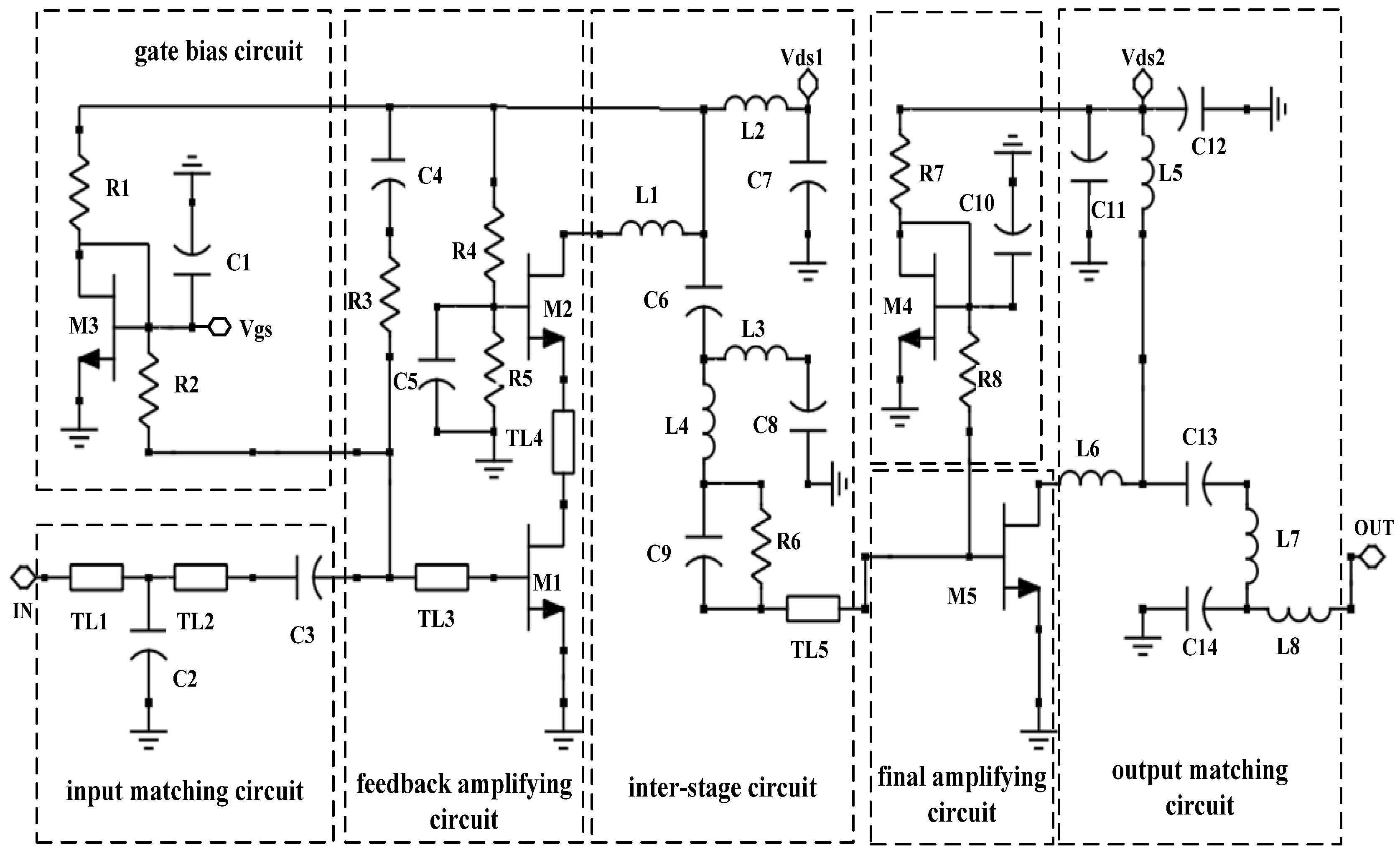

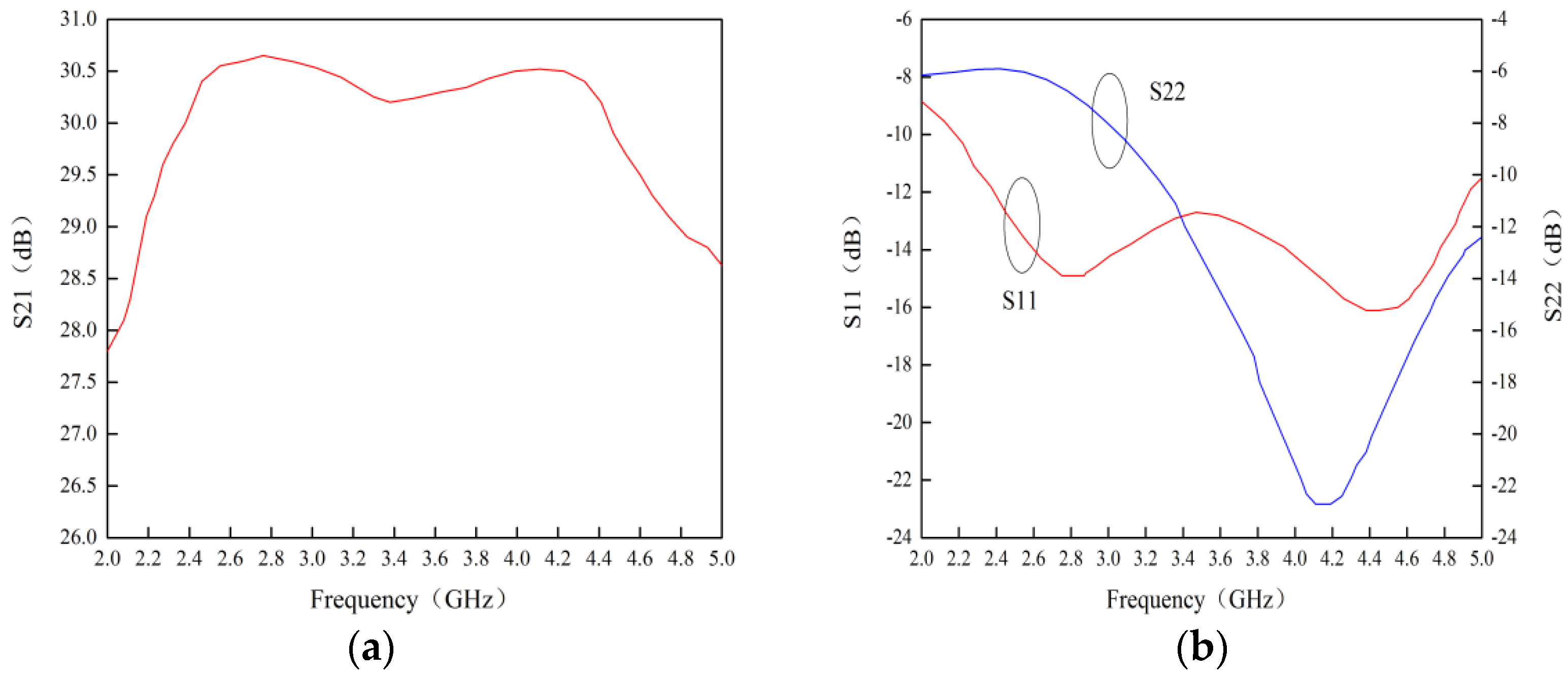


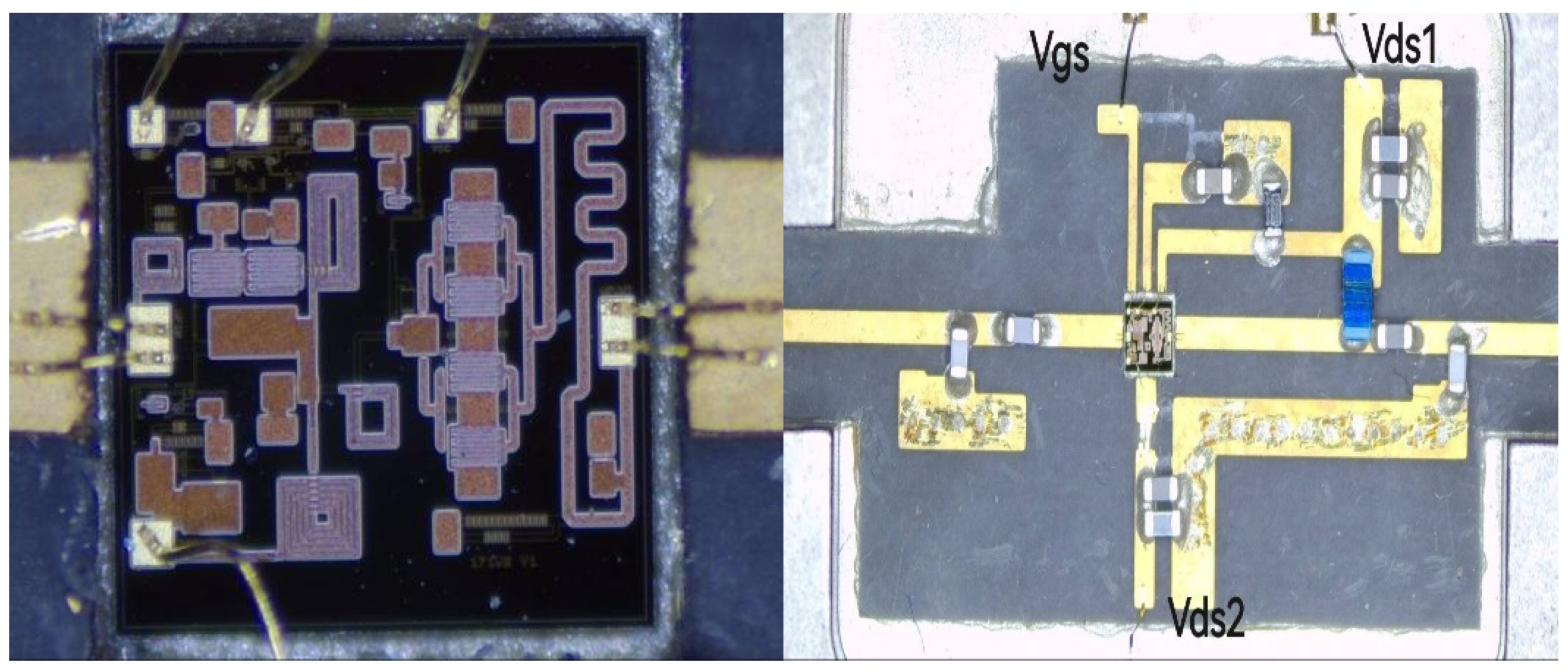
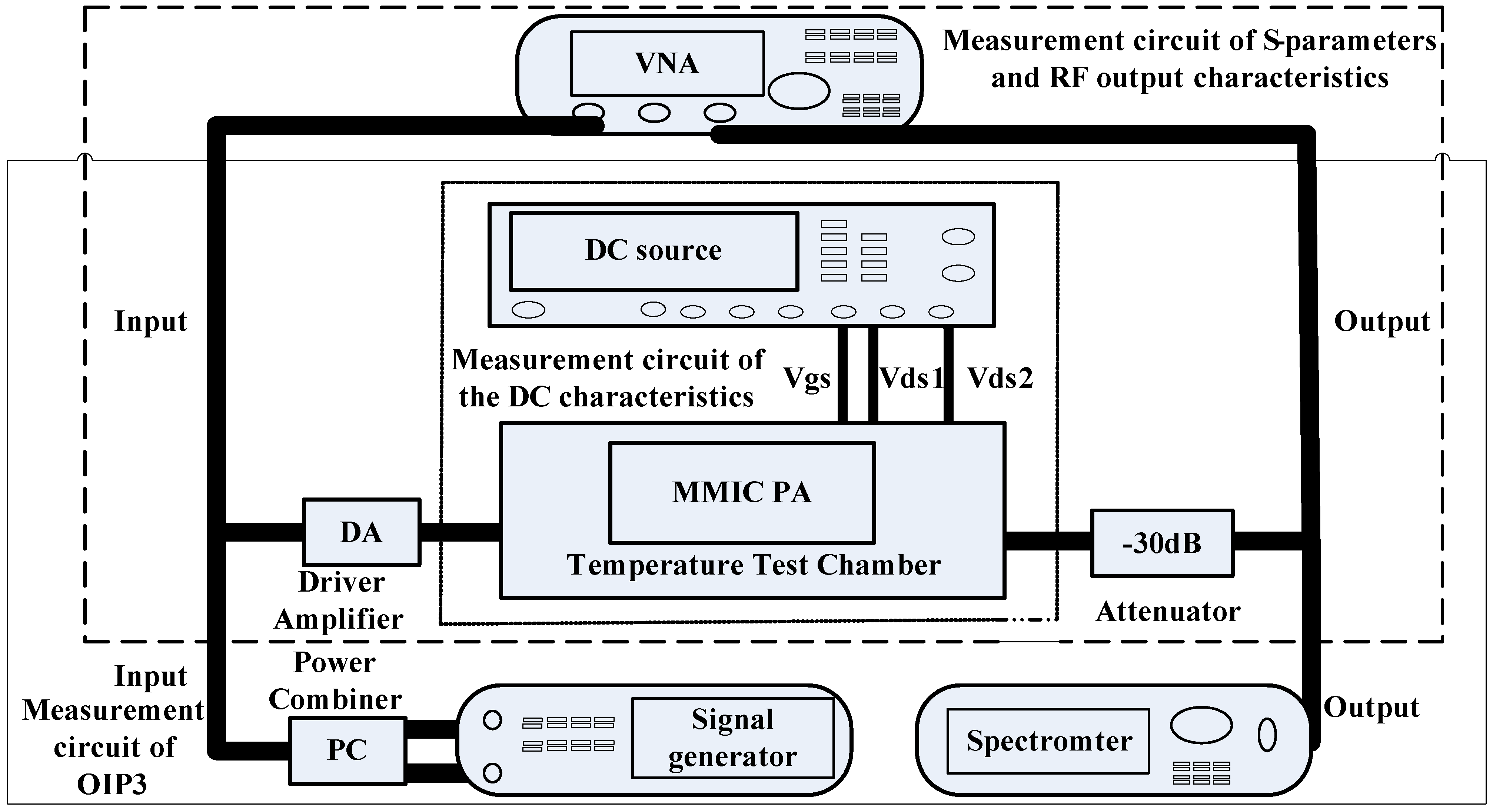

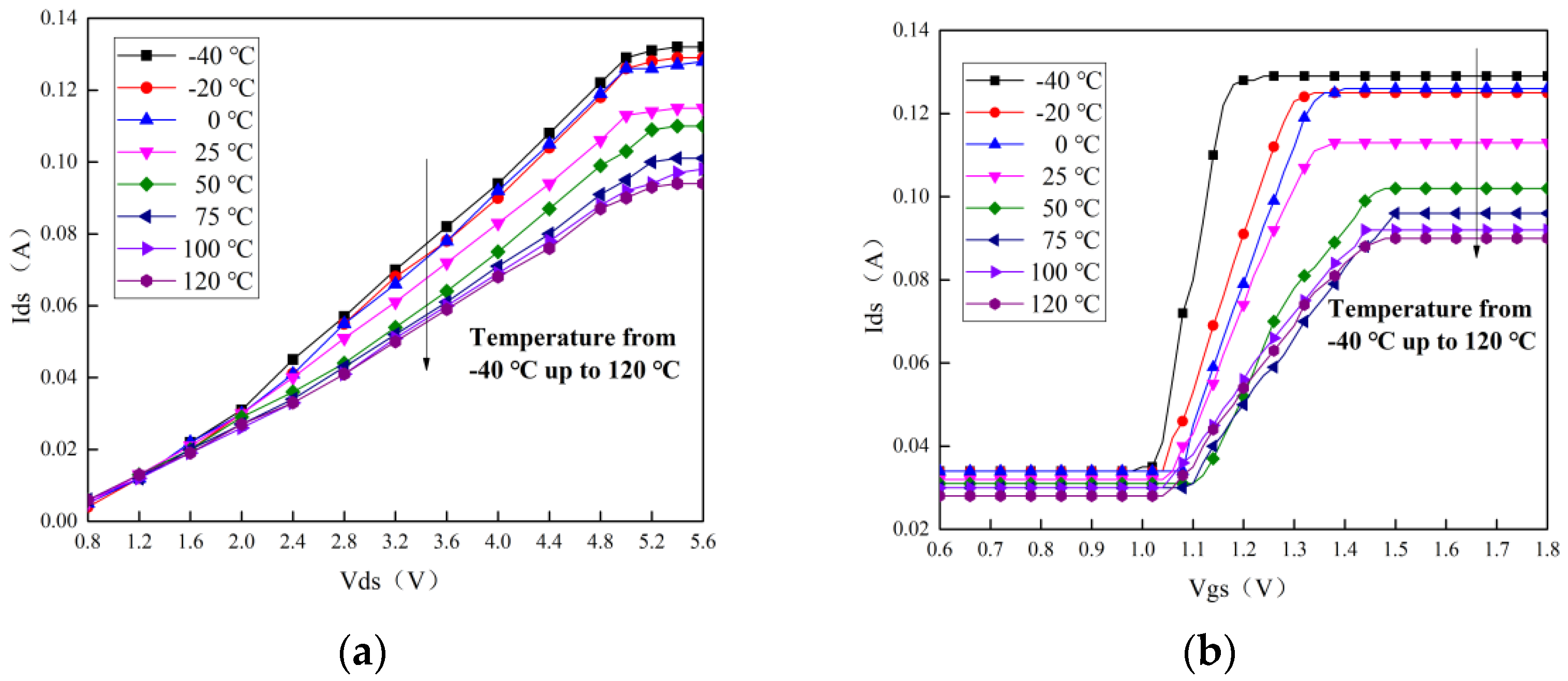

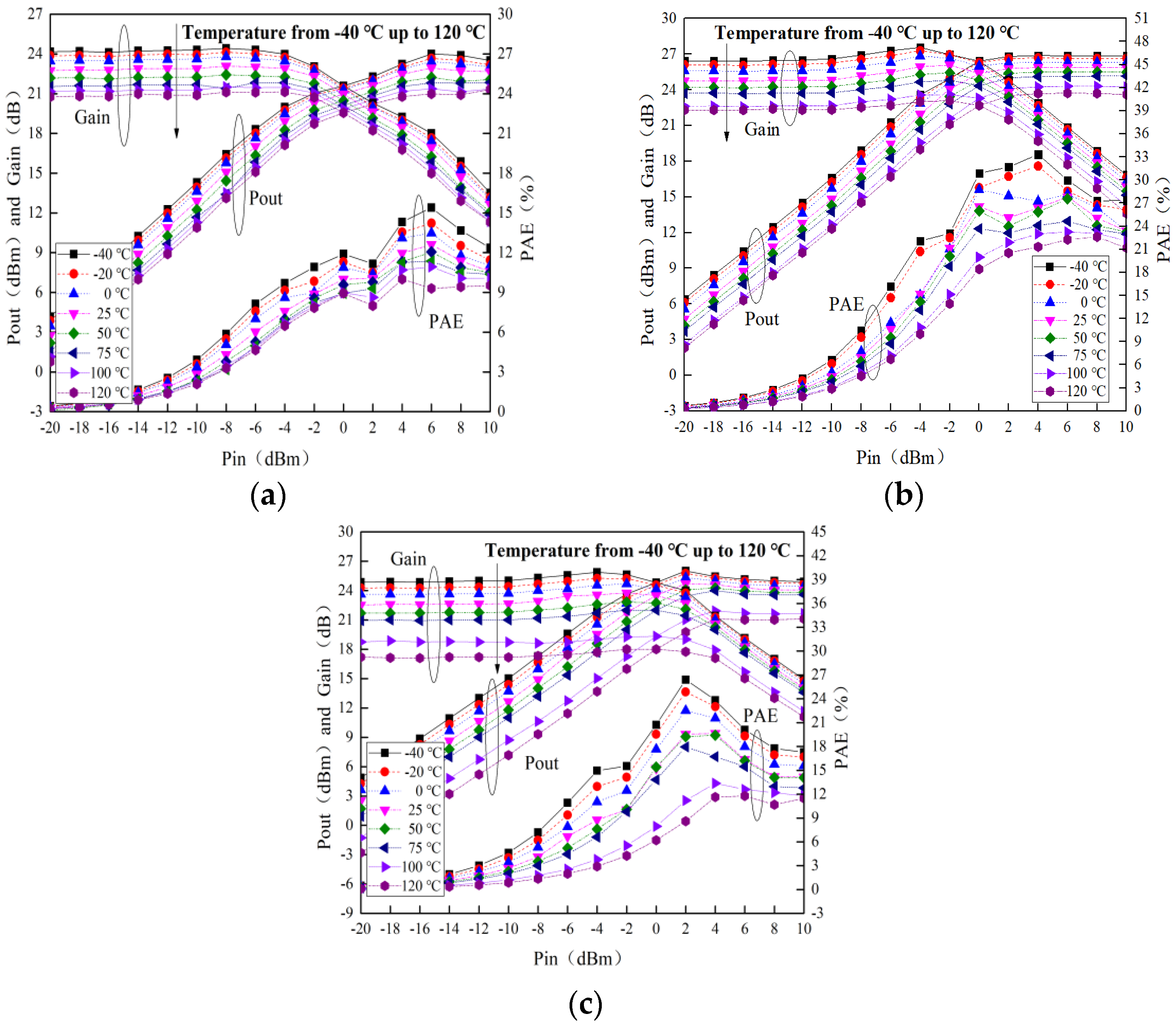
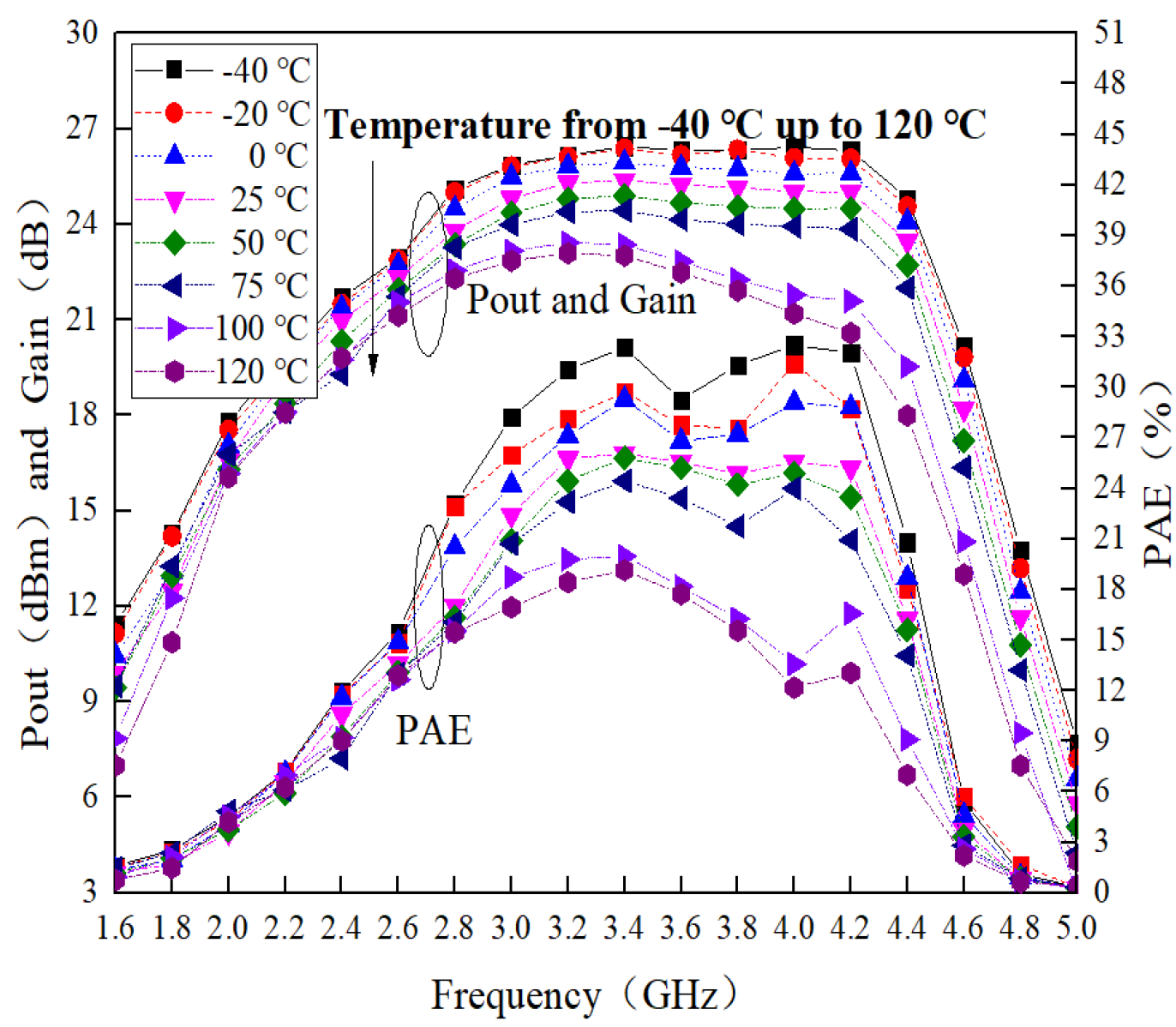
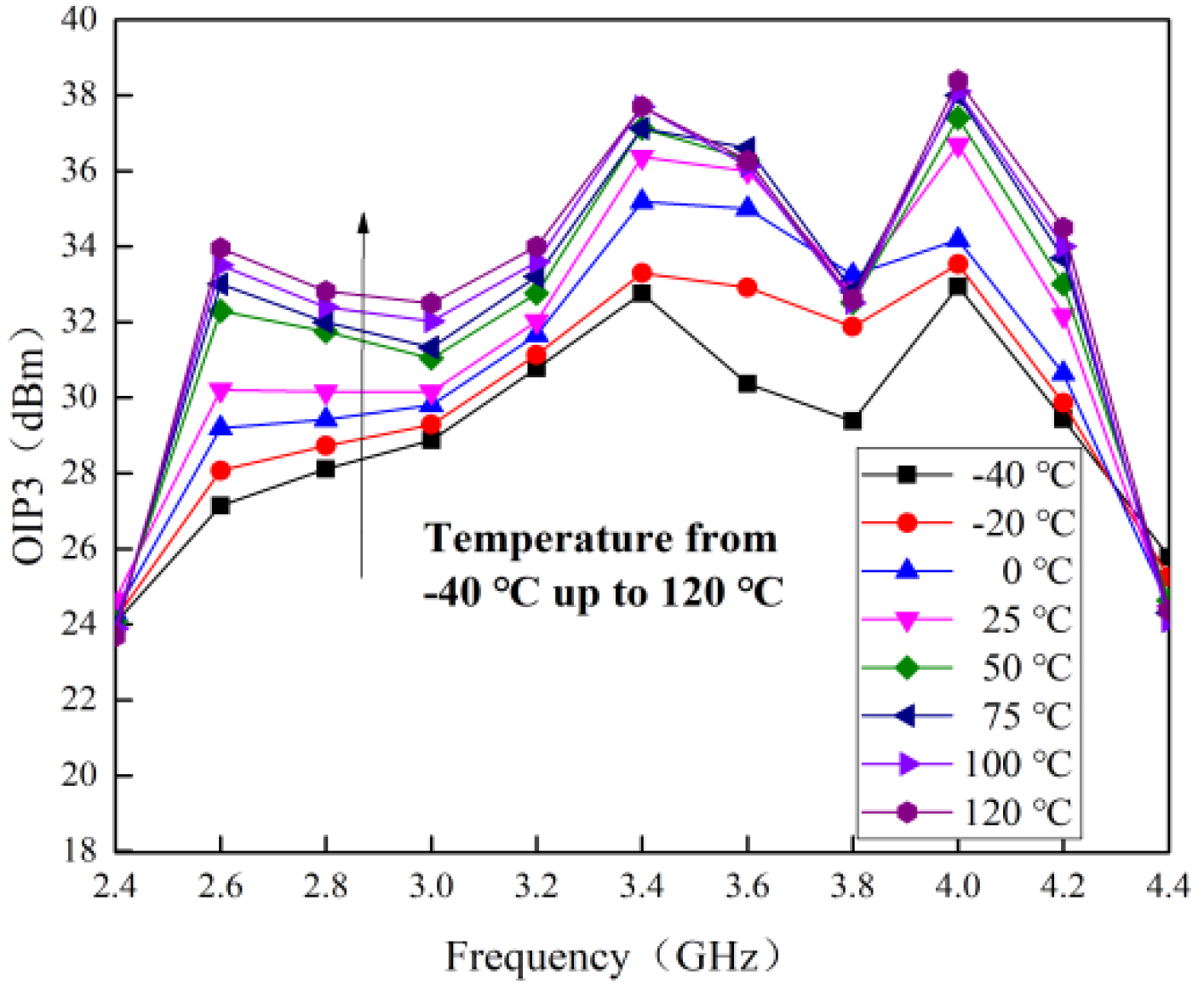
Publisher’s Note: MDPI stays neutral with regard to jurisdictional claims in published maps and institutional affiliations. |
© 2022 by the authors. Licensee MDPI, Basel, Switzerland. This article is an open access article distributed under the terms and conditions of the Creative Commons Attribution (CC BY) license (https://creativecommons.org/licenses/by/4.0/).
Share and Cite
Jia, L.; Lin, Q.; Wu, H.; Wang, X. Performance Degradation Investigation for a GaAs PHEMT High Gain MMIC PA Taking into Account the Temperature. Electronics 2022, 11, 1669. https://doi.org/10.3390/electronics11111669
Jia L, Lin Q, Wu H, Wang X. Performance Degradation Investigation for a GaAs PHEMT High Gain MMIC PA Taking into Account the Temperature. Electronics. 2022; 11(11):1669. https://doi.org/10.3390/electronics11111669
Chicago/Turabian StyleJia, Lining, Qian Lin, Haifeng Wu, and Xiaozheng Wang. 2022. "Performance Degradation Investigation for a GaAs PHEMT High Gain MMIC PA Taking into Account the Temperature" Electronics 11, no. 11: 1669. https://doi.org/10.3390/electronics11111669
APA StyleJia, L., Lin, Q., Wu, H., & Wang, X. (2022). Performance Degradation Investigation for a GaAs PHEMT High Gain MMIC PA Taking into Account the Temperature. Electronics, 11(11), 1669. https://doi.org/10.3390/electronics11111669







